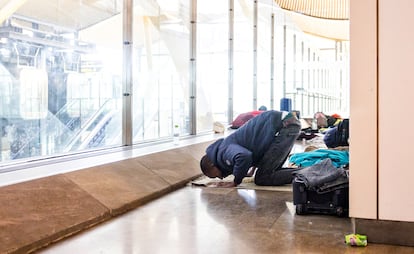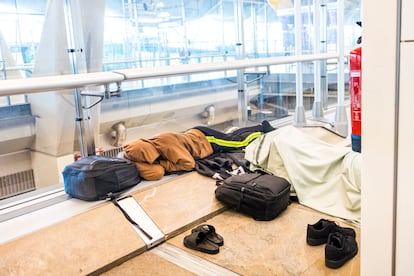Madrid, the new launchpad for migration from Africa to the United States
The Spanish capital’s airport has become a regular stopover for thousands of Senegalese and Mauritanians swapping canoes for a plane. Once they get to Central America, the goal is to enter the U.S., with or without papers

Mamadou landed in Spain on January 28, 19 years after he last left the country. He was one of the tens of thousands of Senegalese who disembarked on the Canary Islands during the so-called cayuco crisis of 2006. But the European dream did not work out well for him. “I held out for two years, but without papers, it was very difficult to find work, and I returned to Dakar,” he said this week, in the transit area of Terminal 4S of Madrid’s Barajas airport. Now 45 years old, he was making a stopover in Madrid before passing through El Salvador on the way to Nicaragua, with the ultimate goal of crossing the U.S. border irregularly. “I am strong, I feel young enough to start again. I don’t think the route, or making a new life there, will be more difficult than what I’ve already been through,” he laughs. Mamadou was surrounded by others. Near the bathrooms, 30 Africans (mainly Senegalese, with some Mauritanians) dozed on cardboard placed on the floor, waiting for the same connecting flight that would leave the next day.
This scene has become the norm. “We’ve seen flights with up to 80 Senegalese. That didn’t happen before,” says an airport employee, who began to notice this growing increase in the number of Africans passing through in September. The airport has traditionally always been a place where almost no one pays attention to who is coming or going, where it’s almost possible for one to set up camp without attracting the attention of fellow travelers. But if you take a closer look, this new phenomenon becomes quite visible. Lately, it has become common to see large groups of young Africans at terminals, waiting to board their flight to Central American countries that do not require entry visas. When they are asked about their final destination, they tend to give the same response: the plan is to take a bus or cab to the Mexican border. Once in Mexico, they will have to survive the dangerous criminal ecosystem that makes its money from the hundreds of thousands of immigrants who look to enter the United States every year.
The number of Africans who arrive at the wall that shields the world’s highest GDP took off last year. On a route once dominated by Latin Americans, their incursion, the outcome of journeys that originate on the other side of the Atlantic, has caught the attention of U.S. authorities. The New York Times published a report a month ago that focused on how this route has grown in such a short amount of time, fed, among other factors, by growing anti-immigrant sentiment in Europe. In addition, the airplane trip with a layover in Europe en route to Latin America is legal and, though more expensive, serves as an alternative to the incredibly dangerous canoe trip to the Canary Islands, where last year nearly 40,000 migrants landed. The land journey across the Americas also involves threats, but none of them are as well-known as those on the Atlantic.

According to the governmental statistics supplied by The New York Times, the number of Africans detained on the U.S. border grew more than 300% and went from 13,406 during the 2022 fiscal year to 58,462 during the same period in 2023. They came from Mauritania (15,263), Senegal (13,526) and Angola and Guinea-Bissau, both with 4,000 migrants each. They make up a small part of the 2.5 million immigrants who are intercepted, but the comparison becomes more dramatic when you look further back. In 2018, for example, only six Senegalese and one Mauritanian were intercepted on the U.S.-Mexico border, according to figures from U.S. Border Patrol. In those days, it was a non-existent route.
The most recent change is that travel packages offered by travel agencies have begun to include a stopover in Madrid-Barajas, one of the main connecting airports with Latin America, with more than 50 million annual travelers. Previously, stopovers had mainly taken place in Turkey. Many emigrants are taking the plunge, egged on by social networks. TikTok, for example, is full of travel offers, animated maps of routes through five countries, images of Senegalese on planes and videos, their expeditions crossing tropical forests, toting their backpacks.
The trip costs between $8,000 and $9,900, according to Associated Press calculations. That’s not counting the extortion that migrants encounter along the way. The main destination is Nicaragua, where entry requirements are lax and affordable, although travelers must usually pass through Bogotá or San Salvador, where since November, the government of Nayib Bukele has been charging Africans and Indians an entry free of more than 1,000 euros under pressure from the United States to control migratory flow to its southern border. The trip to Nicaragua additionally avoids the dangerous pass through the Darien jungle which, controlled by armed groups, marks the border between Colombia and Panama.
That the Senegalese and Mauritanians are exploring this new route is no coincidence. The two nationalities are the protagonists of the migratory route through the Canary Islands and, if even their countries are not suffering from armed conflict, there are many reasons for them to emigrate. In Mauritania, the last country in the world to officially ban slavery — which happened in 1981 — its Black population has denounced multiple abuses. 56.9% of the population lives in poverty, and have access to limited education, health, quality of life and employment, according to official figures. In Senegal, in addition to economic troubles and spiraling inflation, the political climate has become so dependent on which opponents of the government are currently being persecuted, that classes were suspended at the country’s most important university, Dakar’s Cheikh Anta Diop, in order to diffuse last year’s protests.
Relationship to asylum
The emergence of this new migratory route through Barajas helps to partially explain the dizzying increase of asylum requests at the Madrid airport, a phenomenon that has caused the overcrowding of hundreds of asylum seekers and the intervention of judges, the ombudsman and the Labor and Social Security Inspectorate. The uptick began this summer with Somali nationals, who were joined by Senegalese, Moroccans and Mauritanians, among others. All of them, with a ticket to Latin America in hand.
Although there is no official data available on applicants’ trajectories, there are two general profiles among the Africans in Barajas: those who are taking advantage of their stopover in Madrid to request asylum, determined to try to stay in Spain; and those who want to make their way to the United States, but who for various reasons were unable to reach their destinations, and returned to Barajas. The latter group, once in Madrid with no other option but to return to their country of origin, requested asylum. In January alone, 864 applications were registered at the airport, mainly those of Senegalese, according to police data.
After weeks of chaos and overcrowding, the situation is relatively more under control, with about 200 applicants waiting for their requests to be considered and to find out whether or not they will be allowed to stay in Spain. The flow has slowed, largely due to the fact that the Senegalese no longer have easy entry to Madrid. Although the Spanish government will impose a transit visa on them on February 19, the Spanish embassy in Rabat has asked Morocco to get ahead of this measure by preventing from boarding all Senegalese who intend to stop over in Spain without an entry visa for the Schengen Area.
The stranded
Abdoulaye is ashamed to cry, so he covers his face with his hands and sobs, silently. Sitting on the floor of the transit area of Madrid-Barajas Terminal 4, the young Senegalese man, thin as a wire, is reluctant to say what has made him so sad. He broke down, just like that, with no warning. Finally, he takes a breath and, his eyes red, explains that he has been lying on this same floor for seven days, without easy access to food, with no shower; that he had been going with a group of friends to El Salvador to try and enter the United States irregularly, because he wanted to emigrate, but would never want to do so in a canoe. Only, he was unable to board and next week, when he finally manages to get on a plane, he will have to undertake this dangerous and exhausting journey alone.
The transit area of Barajas’ satellite terminal, where Mamadou also waited for his connection, is an image of migratory limbo. Here, some disembarking passengers pass through the police checkpoint to collect their luggage, lugging it hurriedly to avoid missing the next flight. For others, it is purgatory. Not everyone who wants to get to Latin American arrives on the first try, and problems can arise that make the trip much longer than they would have liked. The airlines have to verify a series of requirements before letting them fly, such as the fact that they have a return flight or that the numerous connections that await them are feasible. A common problem has been the payment of the exorbitant fee imposed by El Salvador, the typical connecting airport for those looking to get to Nicaragua, which the airlines must charge in advance. “You can only pay by card, and that hasn’t worked for many of the people here,” explained a group of Senegalese last Sunday.

On Friday, in addition to Abdoulaye, three other Senegalese waited for their flight, plus two Indians and a half-dozen Egyptians, though passengers vary from day to day. For weeks, they have huddled in the quietest hallways, with blankets and sheets of cardboard. There’s nowhere to buy food in this area, so they rely on the kindness and willingness of fellow travelers and workers who are able to go between the transit area and the food court. “If you come back, could you bring me some milk?” asks Abdoulaye.
Mamadou, for his part, sent EL PAÍS a WhatsApp audio message on Saturday: “I am in Mexico.”
Sign up for our weekly newsletter to get more English-language news coverage from EL PAÍS USA Edition
Tu suscripción se está usando en otro dispositivo
¿Quieres añadir otro usuario a tu suscripción?
Si continúas leyendo en este dispositivo, no se podrá leer en el otro.
FlechaTu suscripción se está usando en otro dispositivo y solo puedes acceder a EL PAÍS desde un dispositivo a la vez.
Si quieres compartir tu cuenta, cambia tu suscripción a la modalidad Premium, así podrás añadir otro usuario. Cada uno accederá con su propia cuenta de email, lo que os permitirá personalizar vuestra experiencia en EL PAÍS.
¿Tienes una suscripción de empresa? Accede aquí para contratar más cuentas.
En el caso de no saber quién está usando tu cuenta, te recomendamos cambiar tu contraseña aquí.
Si decides continuar compartiendo tu cuenta, este mensaje se mostrará en tu dispositivo y en el de la otra persona que está usando tu cuenta de forma indefinida, afectando a tu experiencia de lectura. Puedes consultar aquí los términos y condiciones de la suscripción digital.











































